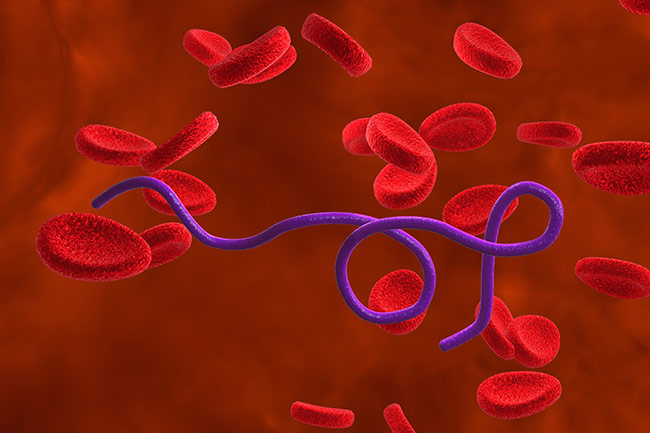Dr. Wayne Anderson Offers a Closer Look at Six Lyme-Related Infections Book excerpt from "New Paradigms in Lyme Disease Treatment"
Bartonella or Bartonella-Like Organism (BLO) Symptom Patterns
 Many people have Bartonella or Bartonella-like (BLO) infections in their bodies. They are perhaps the most abundant infections in people because many veterinarians say that 80 percent of all house cats and nearly 100 percent of all hunting cats carry Bartonella microbes. Fleas bite cats and infect them with the Bartonella-like organisms, which are then transmitted to humans when they get bitten by the flea. Bartonella and BLO infections are therefore probably the most common of the vector-borne Lyme disease co-infections.
Many people have Bartonella or Bartonella-like (BLO) infections in their bodies. They are perhaps the most abundant infections in people because many veterinarians say that 80 percent of all house cats and nearly 100 percent of all hunting cats carry Bartonella microbes. Fleas bite cats and infect them with the Bartonella-like organisms, which are then transmitted to humans when they get bitten by the flea. Bartonella and BLO infections are therefore probably the most common of the vector-borne Lyme disease co-infections.
People who have active Bartonella symptoms have much more pain than people who are manifesting predominantly Babesia-related symptoms. The first thing out of their mouths is usually, “You have to help me with my pain.” They have pain in their joints and the connective tissue around their joints. This joint pain will migrate to other areas of the body. So for instance, patients with active Bartonella might have knee pain, but just when they are about to go to the doctor for the pain, the pain will migrate to the left elbow. The hallmark symptom of Bartonella is sensitivity and tenderness on the bottom of the feet, especially the soles.
Generalized pain in the body, or pain that is sharp and severe, is often related to Bartonella. Bartonella can also cause headaches and ice pick-like pain. Both Babesia and Bartonella cause headaches, but Bartonella headaches are worse. A Babesia headache produces more weird sensations in the head and pressure in the head. People with active Babesia infections will say, “I don’t know if I’d really call what I have a headache. It’s more like a pressure in the head.” Babesia can cause migraines as can Bartonella, but Babesia migraines are generally less severe. Bartonella prefers the occipital areas of the head; the back of the head and neck are generally painful. So pain is a dominant characteristic of Bartonella.
 All of these slow-growing intracellular infections affect the brain but create different symptom patterns, according to which infection is dominant or most active. I see more depression in people with active Babesia but less variability of mood, whereas people with active Bartonella may be irritable and anxious but then “flip over” into depression. Many people with Bartonella infections are misdiagnosed as having bi-polar disorder due to their fluctuating moods; they can easily go from being angry and irritable to being depressed.
All of these slow-growing intracellular infections affect the brain but create different symptom patterns, according to which infection is dominant or most active. I see more depression in people with active Babesia but less variability of mood, whereas people with active Bartonella may be irritable and anxious but then “flip over” into depression. Many people with Bartonella infections are misdiagnosed as having bi-polar disorder due to their fluctuating moods; they can easily go from being angry and irritable to being depressed.
Bartonella-like organisms can also stay on the surface of the organs and tissues and cause a wide array of symptoms. One such symptom is gastritis. In fact, most cases of gastritis that aren’t caused by Helicobacter pylori infections are often caused by Bartonella, which is the second-most common cause of this condition. It can irritate the stomach so that people lose their appetite and/or get heartburn.
Many people with Bartonella infections are misdiagnosed as having bi-polar disorder due to their fluctuating moods; they can easily go from being angry and irritable to being depressed.
Bartonella can cause a low-level, relapsing sore throat. People with active infections will periodically awaken with sore throats and wonder if they are coming down with a cold, but then the sore throat will go away.
Bartonella irritates the bladder and can cause frequent urination, interstitial cystitis, or other chronic inflammatory conditions of the urinary system.
Bartonella can also cause fevers, but for patients to be able to run a fever, they need to have a relatively functional immune system, so not everyone who has a Bartonella infection will get a fever. Yet people will often feel hot, as if they have a fever, but their body temperature may be below normal.
Bartonella can affect the eyes and cause conjunctivitis, or inflammation of the outermost layer of the eye, which results in irritated, dry red eyes, as well as other eye problems.
Bartonella cause more skin-related problems than the other infections. Red bands or stretch marks on the skin called striae are common, as are acne and other skin problems.
Bartonella lives in the liver and spleen where it inflames these organs and compromises their functioning. When the liver and spleen are inflamed, the filtering capacity of the blood is affected, resulting in thick blood. People with Bartonella may have slightly elevated liver enzymes on lab tests. For instance, the alanine aminotransferase (ALT) test score may be just outside of the normal range and high only intermittently. The inflammation that Bartonella causes in the liver and spleen can compromise the body’s detoxification system in a major way, though. When the spleen is compromised, the lymph glands may also become swollen, which then causes the lymph flow to become thick, sludgy and slow.
Borrelia Symptom Patterns
 Borrelia symptom patterns are a bit harder to define because this organism isn’t as aggressive as the others. The distinguishing symptom that it causes is fatigue; people who have active Borrelia symptoms tend to have more fatigue than those whose predominant symptoms are due to Bartonella or Babesia. People with active Babesia and Bartonella are much more restless than those with active Borrelia infections. All of the infections cause exhaustion; that is ubiquitous within the entire family of neurotoxin infections, but Babesia and Bartonella cause more restlessness, whereas people who are primarily manifesting Borrelia symptoms are often more tired. Feeling “wired and tired” is common with all the neurotoxin diseases, so I am really just focusing on the shades of gray here.
Borrelia symptom patterns are a bit harder to define because this organism isn’t as aggressive as the others. The distinguishing symptom that it causes is fatigue; people who have active Borrelia symptoms tend to have more fatigue than those whose predominant symptoms are due to Bartonella or Babesia. People with active Babesia and Bartonella are much more restless than those with active Borrelia infections. All of the infections cause exhaustion; that is ubiquitous within the entire family of neurotoxin infections, but Babesia and Bartonella cause more restlessness, whereas people who are primarily manifesting Borrelia symptoms are often more tired. Feeling “wired and tired” is common with all the neurotoxin diseases, so I am really just focusing on the shades of gray here.
Borrelia causes pain, but the pain is much more diffuse and spread throughout the body. It also can be muscle-related and fibromyalgia-like, rather than primarily in the joints, as with Bartonella. However, doctors and patients need to keep an open mind when it comes to diagnosis and not over-generalize about symptom patterns. For instance, there is a subset of Borrelia patients who have arthritic-like symptoms and lots of inflammation in their joints, although I see this maybe less than 10 percent of the time.
The symptoms of Borrelia can be a mixture of a little of what’s found in all of the other Lyme-related infections.
Borrelia affects the nervous system, but it’s a bit more “ghost-like” in the symptoms that it causes, so it’s not as defined or specific. If patients have been adequately treated for Babesia and Bartonella infections and have only 20 percent of their symptoms remaining, such as a bit of fatigue, achiness and brain fog, I might suspect that they still have some Borrelia microbes that need to be addressed.
Lyme microbes are smart and are looking for hiding places in the body; they want to be invisible and disguise themselves from the immune system. This means that they don’t stay in the blood for long and quickly go to areas of poor circulation, to avoid being attacked by the immune system. Their goal is to lull the intracellular environment into complacency. For instance, Borrelia is able to change its form and alternate between the spirochete, cell-wall deficient and cyst forms as a way of confusing and hiding from the immune system.





























Are there any articles on Alpha Gal. My daughter I believ has this form. I have Lymes misdiagnosed twice. My friend who have degrees in this. D.C. Went on Doxie for. 30 days. I love working in the yard. (Dozens of deer) we live in the Poconos PA. I still work in the yard however no I am afraid of these ticks.
Hi Patricia,
Here’s an article on Alhpa Gal: https://www.lymedisease.org/tick-bites-meat-allergy/
Please do your very best to protect yourself when working in your yard.